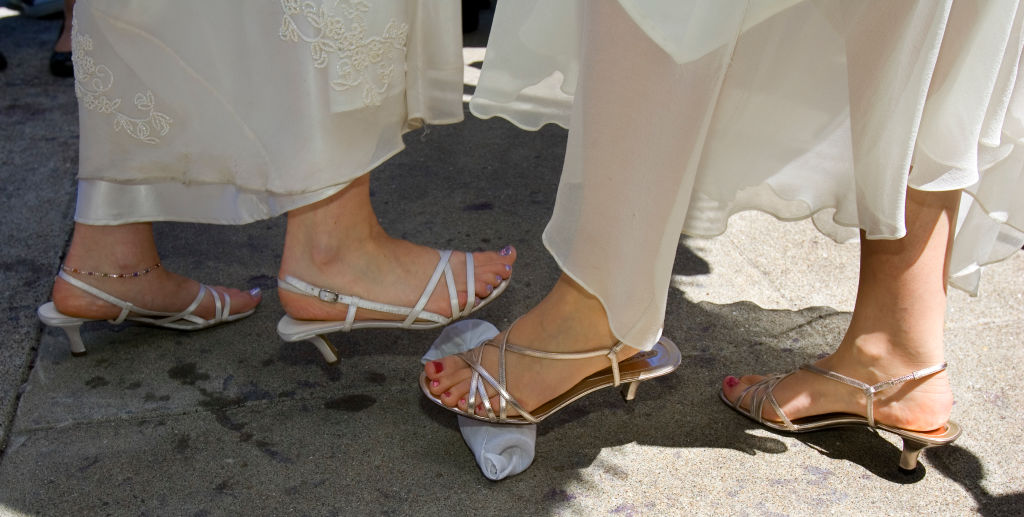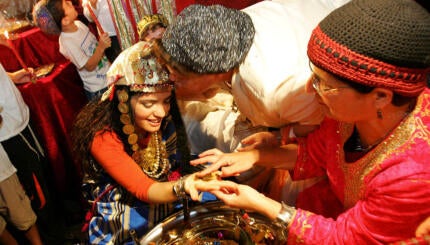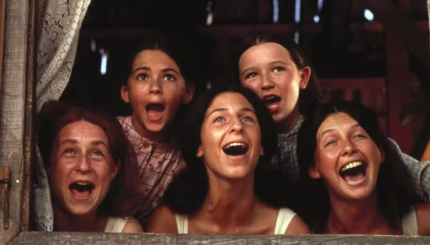As a straight post-denominational rabbi who has advocated for women’s rights and gay rights in Jewish ritual practice, and who has done much work in the area of Jewish marriage and divorce, I think that straight couples have much to learn from gay couples when it comes to designing their wedding ceremony. Opening up the question of how one publicly sanctifies in a Jewish way the union of same-sex couples — and the halakhic (Jewish law) dialogue that entails — gives us viable options for sanctifying a heterosexual couple’s wedding in similar ways in order to reflect egalitarian values.
READ: Are Egalitarian Jewish Weddings Possible?
The “Brit Habat” Example
Like modern heterosexual Jewish couples, gay Jewish couples are trying to strike the balance between tradition and modernity. Yet one advantage same-sex couples have is that there is no traditional same-sex wedding Jewish ceremony. Of course, this is ideologically problematic. But it is fact. So once one makes peace with this reality, this can prove to be a blessing in disguise. As much as many of us look forward to the day we will stand beneath the chuppah (wedding canopy), the traditional Jewish ceremony is not egalitarian and is highly gendered. Gay couples, therefore, are essentially starting from scratch to create a ceremony that reflects their own values yet also looks and feels like a Jewish wedding.
This is how I felt when I created my oldest daughter Michal’s “brit habat” ceremony welcoming her into the covenantal community of the Jewish People. There is no traditional ceremony to welcome a Jewish baby girl into the Jewish people. And while this bothered me — even offended me — it was also liberating. I was free to build a ceremony based on Jewish texts and customs, but I was not tied down to an already existing ceremony that did not necessarily express what was in my heart at that amazingly emotional and pivotal moment in my life. That is why, when my oldest son Adin was born two years later, I did not settle for the traditional ceremony. Instead, my husband Jacob and I combined the traditional brit milah ceremony with some of the elements we had included in Michal’s brit habat ceremony. At that point we felt it would be shortchanging our son to simply go with the traditional ceremony without any embellishments.

For more on Jewish baby naming ceremonies, click here!
With your help, My Jewish Learning can provide endless opportunities for learning, connection and discovery.
This is one way I see same-sex wedding ceremonies influencing male-female wedding ceremonies in the future. As straight couples attend their gay friends’ wedding ceremonies and see all of the thought that went into creating their ceremonies, I would hope that they would not want to settle for less. Moreover, when they experience a truly egalitarian wedding ceremony that reflects their modern view of what marriage is meant to be, I should hope they would also not settle for less. This is the second way I see same-sex wedding ceremonies influencing male-female wedding ceremonies.
The Problem With the Traditional Jewish Wedding Ceremony
A traditional Jewish wedding ceremony is essentially the husband acquiring the wife, or, more specifically, her sexual exclusivity. When a Jewish man places a ring on a Jewish woman’s finger and says, “Harei at mikudeshet li bitabaat zu kidat Moshe v’Yisrael,” (“Behold you are consecrated unto me with this ring in accordance with the law of Moses and [the People of] Israel”) he is performing a unilateral legal act that binds the woman to him forever unless he chooses to release her by giving her a writ of divorce, a get. The woman stands silently underneath the chuppah while he does this act, because she is not doing the same vis a vis the man. She is not setting him aside for her exclusively. On the biblical level of Jewish law, a traditional Jewish marriage means that the woman must be loyal to the man but that the man can have as many wives as he wants. This is a monogamous relationship only as far as the woman is concerned. And since she is not binding her husband to her in any way, he needs no consent from her to end the relationship. He writes her a get and the relationship is over.
On a rabbinic level, the picture is different. In 1040 C.E. Rabbeinu Gershom issued an edict in Ashkenaz banning polygamy and requiring consent to divorce from the woman. In other words, he can marry only one wife, and that wife must accept the get for there to be a divorce.
For more on Jewish divorce, click here!
This sounds like the problem is solved from a feminist point of view. But in reality it is not. Because Rabbeinu Gershom’s edict is only rabbinically enacted, the biblical model of marriage trumps his edict in cases where problems arise. For example, if a man wants a divorce and his wife does not agree, he can gather 100 rabbis to sign a document claiming that she is being unreasonable and that therefore he is allowed to marry another woman. When a woman wants a divorce but her husband refuses, she is stuck, chained, becoming an agunah. This is the case even if he beats her. The rabbis on the case can send him to prison or make his life difficult, but they cannot force him to write a get, and they cannot write it themselves. That is the traditional Jewish model of marriage that each and every couple enters into and reinforces when they choose to marry in a traditional Jewish wedding.
How to Create a More Egalitarian Ceremony
But this is not the way it has to be. There are a variety of changes a couple can make to create a more egalitarian ceremony — ranging from changes that are just cosmetic but do not affect the unilateral nature of the transaction and therefore do not solve the get issue, to changes that alter the entire basis of the transaction so it is completely bilateral so that the get issue is solved.
I was fortunate enough to be the misaderet kiddushin (officiating rabbi) at a ceremony in Baltimore that fit into the latter category. Rather than use two rings in their ceremony to make it more egalitarian, this couple chose not to use rings at all. They wrote up a contract that is binding under both Jewish and American law and that covers their obligations to each other in marriage as well as the arrangements they agree to should they divorce. This contract they signed under a traditional chuppah, albeit one that they entered together. Moreover, the central act binding the couple together was not an act of unilateral kinyan, of one-sided acquisition, but rather of both bride and groom taking a neder/shevuah (vow) establishing bilateral exclusivity; therefore, no get was required. And this ceremonial act was followed by two sets of sheva brachot — the traditional seven blessings recited beneath the chuppah, in addition to seven poetic renditions of these blessings that the groom composed to reflect the couple’s personal values.
READ: Adapting the Sheva Brachot for LGBT Weddings
The bride at this wedding also did not wear a veil. And the couple did not even have a traditional ketubah (Jewish wedding contract). Surprisingly enough, however, the wedding felt very “Jewish.” Enough of the elements were there for it to retain its Jewish character. Yet the couple did not have to compromise their egalitarian values.
There are less radical changes a couple can make to the traditional wedding ceremony to make it more egalitarian. For instance, if a couple does want to include rings, a double ring ceremony can be appropriate. When the ring is given and what is said will depend on the officiating rabbi and the couple’s own desires in terms of how traditional they want to ceremony to be and whether or not they want the act of kinyan (acquisition) to be in effect. If the bride gives her ring to the groom after he gives her his ring, especially if she does not say the same formula he does (in other words, if she says something like “ani ledodi v’dodi li” (“I am my beloved’s, and my beloved is mine”) instead of “harei atah mekudash li…”), then the kinyan should still be in effect. This is a cosmetic change that will make the ceremony appear more egalitarian but will not solve the get issue.
Therefore, in such a case, the couple should sign a halakhic (Jewish law) pre-nuptial agreement that requires either partner who is refusing to cooperate with the divorce proceedings (the man refusing to give the get or the woman refusing to accept it) to pay a certain sum of money each month until he or she agrees to cooperate. This does not solve the get issue, and it does not make the ceremony halakhically egalitarian (because the kinyan is still unilateral), but it does create an incentive for each side to cooperate. If the woman refuses to cooperate, 100 rabbis can still be gathered, of course. But if the man refuses, the court can take measures to make his life difficult, but they cannot make him give the get. There are men in Israel sitting in jail rather than giving their wives a get.
READ: Updating the Traditional Jewish Wedding
Or the couple can choose to do “kiddushin al-t’nai” (conditional marriage). This is the method advocated by the Conservative movement. In such a case, the man signs a statement that the marriage only is in effect as long as he does not refuse to give a get. In effect, this solves the get issue, but in spirit the kinyan is till in effect. It is simply nullified if the man chooses to wield his inherent power over the woman. That is why this is not my personally preferred method. It is a more of a Band-Aid than a cure and does not satisfy those in search of a true ideological solution—i.e a ceremony that lifts up the values an egalitarian community holds dear and reflects what is considered to be the meaning of modern marriage.
If she gives the ring first and does say the traditional formula (“harei atah mekudash li betabaat zu kidat Moshe v’Yisrael”), then the ceremony will appear egalitarian but his act of kinyan will not be in effect, because her recitation of this formula nullifies his recitation, since the acquisition is meant, halakhically speaking, to be unilateral. So if the couple decides to divorce, a get will not be required. In such a case, the divorce is handled by the civil courts of the country in which they live. In Israel, however, since there is no such thing as civil marriage and divorce, the couple should write up a pre-nuptial agreement with a lawyer stipulating the conditions and process of their possible divorce.
Another option is to do what is called “derech kiddushin,” which is a method of marriage mentioned in the Talmud that is considered less binding but also does not contain the act of kinyan and therefore does not require a get. In such a ceremony, the formula recited is “harei ani meyuchad lach kidat Moshe v’Yisrael” when the man gives the woman a ring, and “harei ani miyuchedet lecha kidat Moshe v’Yisrael” when the woman gives the man a ring. The benefit of this ceremony is that it is mentioned in the Talmud but also is completely egalitarian. But because there is no halakhic way mentioned in the Talmud to dissolve such a marriage, if the couple lives outside of Israel, they can rely on the civil courts. But if they are in Israel, or if they want to work a “Jewish” way of divorcing into the ceremony itself, they can draw up a contract based on the laws of shutafut (partnership). The original basis for these laws is in business dealings, but they can easily be transferred to a marriage. Rachel Adler in her book, Engendering Judaism, calls this a “brit ahuvim,” and this document can also include a statement about how the couple envisions their future life together and can take the place of the traditional ketubah.
There are other options for couples who are looking for ways to make their ceremony more egalitarian, many of which are listed on the Alternatives to Kiddushin website. My personal vision for Jewish marriage is that straight couples will learn from their gay brothers and sisters that the wedding ceremony can be Jewish yet still reflect the couple’s egalitarian values and vision for their marriage. What may have started from the handicap in the gay Jewish world of having no traditional precedent to rely on has proven to be an impetus for much needed creativity and change in the area of Jewish weddings. I only hope that this positive outcome will continue to seep into the straight world until it changes the face of Jewish marriage all together.
Rabbi Dr. Haviva Ner-David is founding director of Reut: The Center for Modern Jewish Marriage, and Shmaya: A Ritual and Educational Mikveh in Galilee. She is the author of two memoirs: Life on the Fringes: A Feminist Journey Towards Traditional Rabbinic Ordination, and Chanah’s Voice: A Feminist Rabbi Reclaims the Mitzvoth of Baking, Bathing, and Brightening.
Reprinted with permission of Keshet, a national organization that works for full LGBTQ equality and inclusion in Jewish life.
chuppah
Pronounced: KHOOP-uh or khoo-PAH, Origin: Hebrew, canopy under which a Jewish wedding ceremony takes place.
Moshe
Pronounced: moe-SHEH, Origin: Hebrew, Moses, whom God chooses to lead the Jews out of Egypt.
Talmud
Pronounced: TALL-mud, Origin: Hebrew, the set of teachings and commentaries on the Torah that form the basis for Jewish law. Comprised of the Mishnah and the Gemara, it contains the opinions of thousands of rabbis from different periods in Jewish history.


